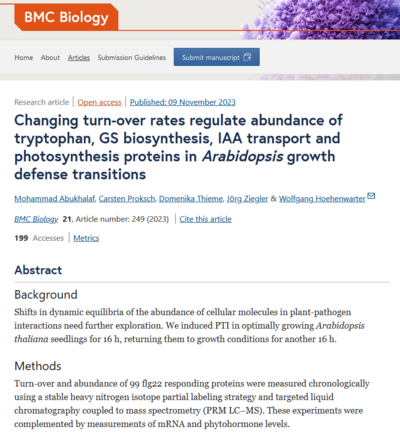Proteomics of growth and defense.
The activation of plant defense mechanisms against pathogens is energy-intensive and therefore often occurs at the cost of growth and development. The molecular basis of this growth-defense trade-off is realized by dynamic protein synthesis and degradation processes. Using a comprehensive proteomics and transcriptomics approach, IPB scientists have recently determined protein turnover during and after an induced defense response. To do this, they grew Arabidopsis plants in a culture medium supplemented with flg22. This peptide is derived from bacterial flagellin and elicits strong defense responses in plants. After induction of the defense reaction, the plants underwent a recovery phase in flg22-free medium.
The researchers investigated the turnover and abundance of 99 Arabidopsis proteins that are known to play a direct or indirect role in the pathogen defense. For that, they determined the synthesis and degradation rates of these proteins during and after the defense response using targeted liquid chromatography and coupled mass spectrometry. They also analyzed the corresponding mRNA concentrations and the behavior of the phytohormone auxin, which plays an important role in plant growth processes.
As a result, they could show that the mRNA transcripts and the corresponding enzymes of tryptophan biosynthesis increased significantly when flg22 was applied. The amino acid is the starting point for the production of early defense substances such as glucosinolates, but also for the generation of auxin. In case of the defense scenario, however, tryptophan mainly feeds the glucosinolate production, as the Halle scientists observed increased expression rates for the corresponding biosynthesis enzymes, while the general auxin level in the entire plant decreased. The auxin transport proteins, which manage the phytohormone's distribution, were also strongly downregulated. Thus, not only the reduction of the total auxin amount, but also its transport and localization within the plant is important for the switch from growth to defense metabolism.
As expected, the Halle plant experts could also record a decrease in the quantities of photosynthesis proteins. Apparently, defense stress leads to a redirection of the entire photosynthetic electron flow, so that the light reaction no longer fuels the production of NADPH but of reactive oxygen species. This, in turn, helps fight a broad spectrum of pathogens.While the mRNA concentrations of all proteins examined fell back to their baseline level after the recovery phase, the concentrations of the proteins themselves remained elevated even 16 hours after the switch to flg22-free medium. The remodeling of the proteome is energetically costly and apparently occurs even after the stress stimulus has subsided more slowly than the response of the transcriptome. The prolonged presence of the defense proteins could indicate a priming state with which the plant prepares itself for future pathogen attacks, the scientists speculate. Their results shed light on a complex regulatory scenario of time- and context-dependent protein expression when switching between growth and defense.


